Last updated: June 19, 2023
While planning my trip to Victoria and Vancouver Island in 2021, I learnt about the cool-sounding “Orcas: Our shared future” exhibit at the Royal BC Museum. These giant marine creatures have been in my Top 5 of favourite animals for many years, so of course, I had to check it out!
After being in the making for five years, this exhibit opened in mid-April 2021 and ended on March 31, 2022. It covered 10,000 square feet, and featured 10 movie presentations and 7 interactive games for its visitors.
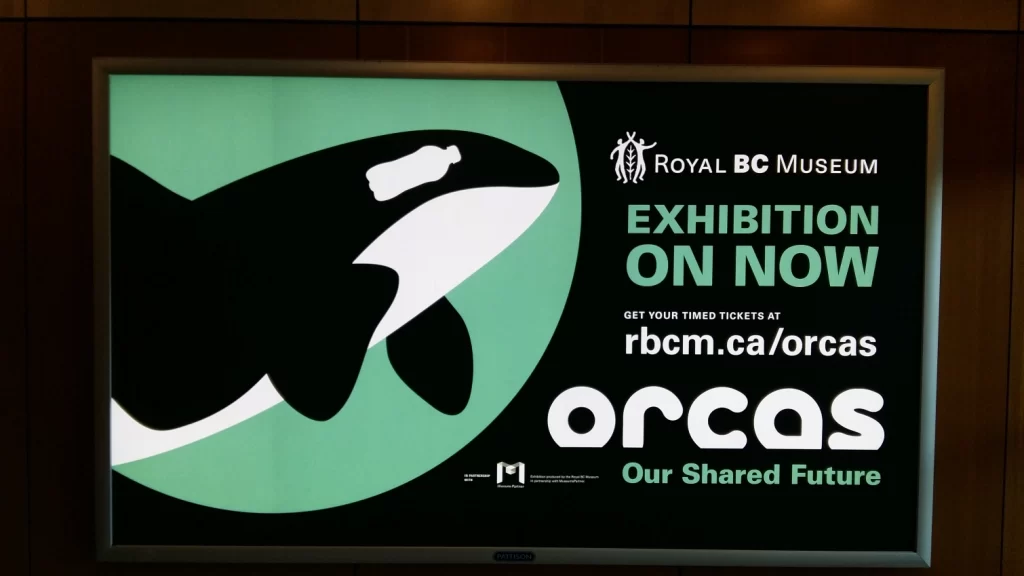
The Royal BC Museum Corporation was founded in 1886, and as per its website, is “one of Canada’s greatest cultural treasures”. In a nutshell, its core galleries (Natural History, Becoming BC, Our Living Languages, and First Peoples Gallery), and temporary exhibits teach visitors about British Columbia’s natural and human history.
The IMAX Movie Theatre is in the same building, where you can watch both educational and commercial films. The Royal BC Museum stands on the traditional territories of the Lekwungen (Songhees and Xwsepsum First Nations), who have lived here for many years.
Lastly, this is one of Victoria’s most popular tourist attractions (860,000 visitors in the 2018/19 season), and is only steps away from the Inner Harbour and Empress Hotel in downtown.
After taking an escalator to the first floor, where the Orcas exhibit was displayed, the first thing you saw was the whale tail-shaped entrance door. What a great way to start a museum tour!
Right after entering, visitors were greeted by Ruffles, Slick, and her daughter, Scarlet, three local orcas hanging from the ceiling, who, of course, weren’t real, but 3D printed replicas. They were Southern Resident Orcas, and each replica looked exactly the same as the original. For example, Scarlet had several scratches and scars on her body, which were caused by her difficult birth, when other orcas of her clan had to pull her with their teeth out of her mother’s womb.
There was very little light in this room of the exhibit, and several screens on the left and right showed marine creatures, just swimming around and singing, and you could hear them breathe, by listening to the bubbles rising up to the “surface”. Some of them were orcas close to the replicas, so Ruffles, Slick, and Scarlet felt comfortable, and it felt like you’re right there with them in their home!
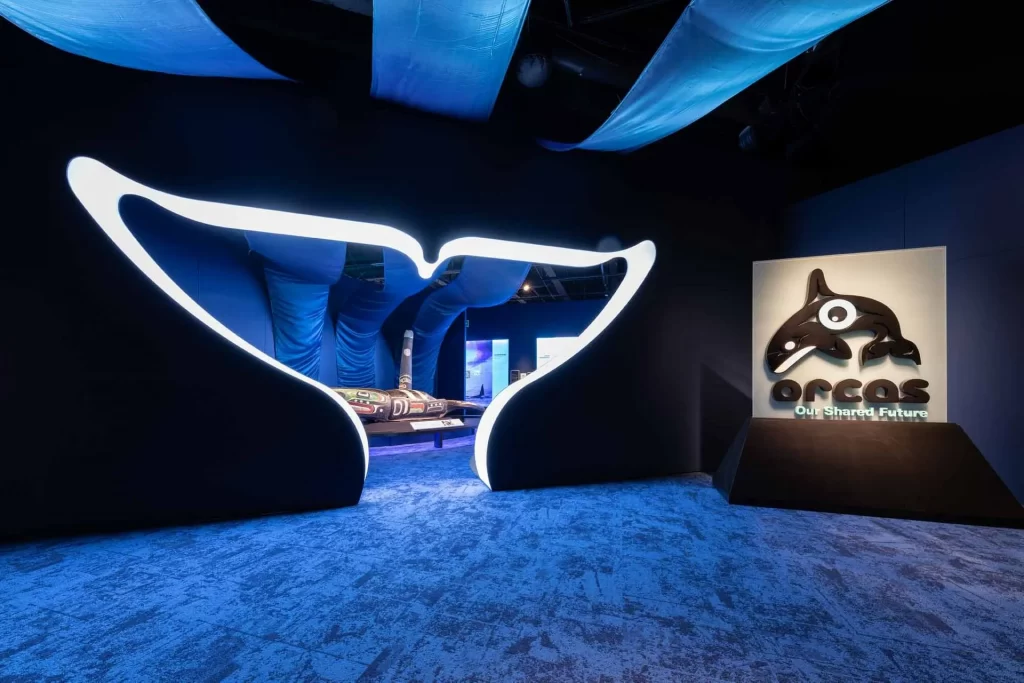
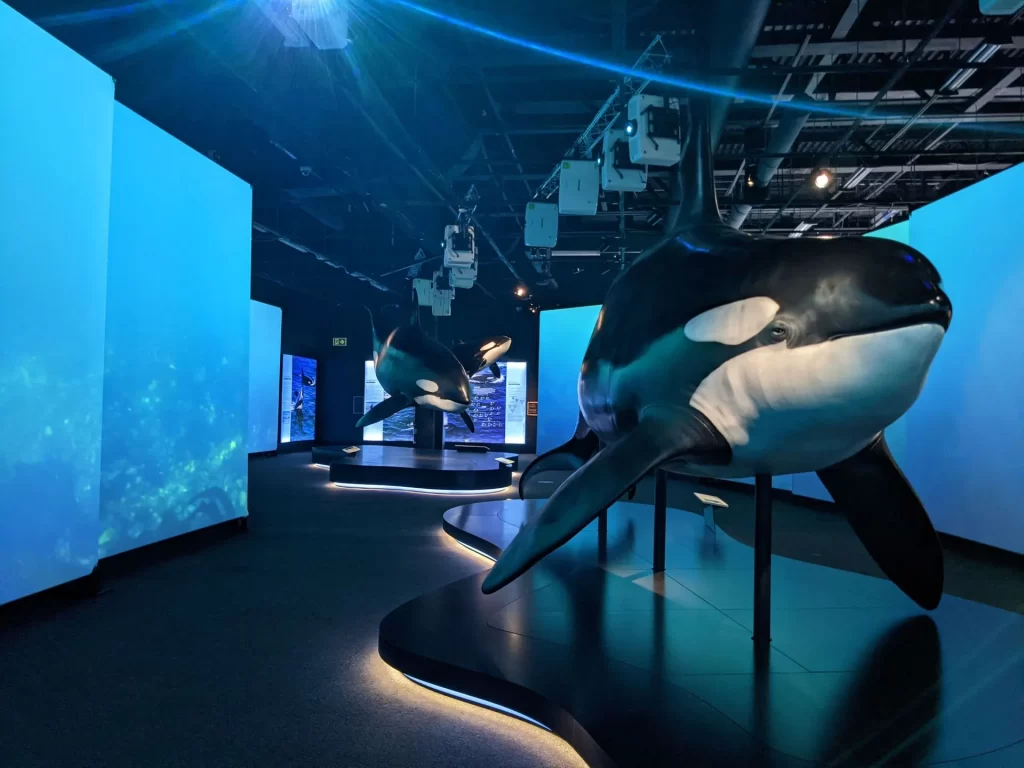
The whale tail-shaped entrance door, and the three 3D printed orca replicas, and screens on both sides. Both photo courtesy of the Royal BC Museum.
Then I walked to the next section of the exhibit, which showed a bunch of panels with cool information about orcas. For example. did you know that more than a dozen orca species live in all oceans, both inside the Northern and Southern Hemisphere, and they are distinguished by their behaviour, hunting styles, anatomy, and diet?
Apart from the Southern Resident Orca, who eat mostly Chinook salmon, the Bigg’s (Transient) Orca, who’s diet consists of other whales, seals, and sea lions, and the Offshore Orca, who prefer to eat sharks and other fish, call the North American west coast home.
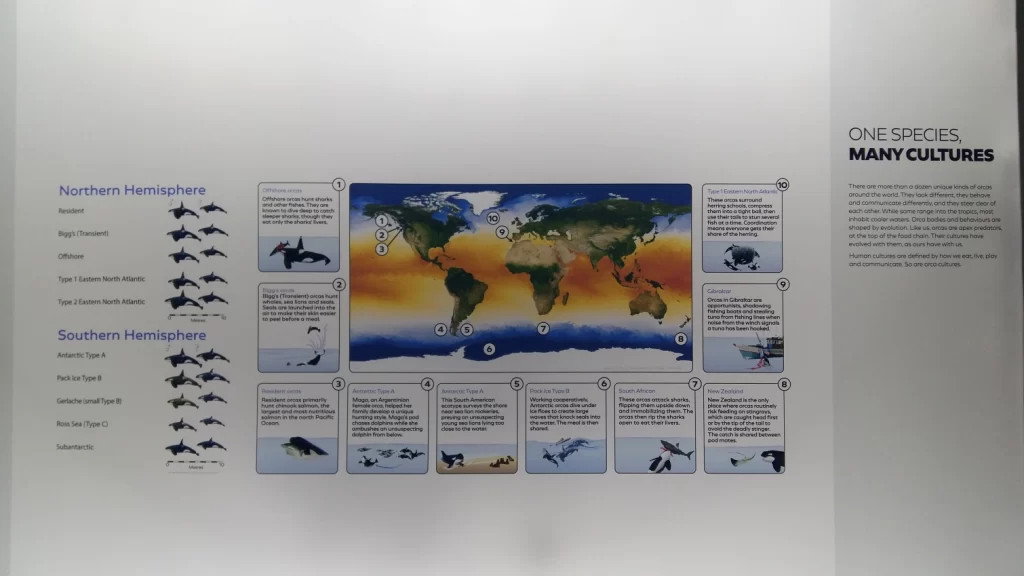
Another panel in this section taught visitors about the orca’s anatomy, and that females can weigh up to 5,000 kilograms (11,023 lbs), and can be up to 8.5 meters long (27.88 ft), and live up to 80 years in the wild! Males, on the other hand, can even weigh up to 6,000 kg (13,227 lbs), and get up to 9.5 meters (31 ft) long, but “only” live up to 60 years!
Lastly, they can stay underwater for up to 17 minutes, like to swim 55 to 60 km (34 to 37 miles) per hour(!), and can dive up to 260 meters (853 ft) deep.
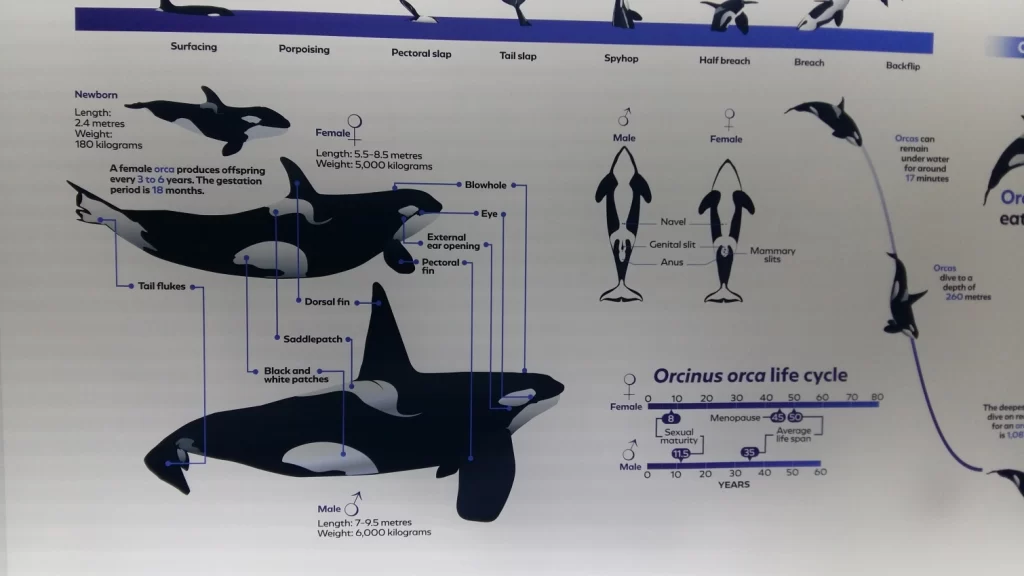
Next, did you know that orca species around the world live and travel in pods (e.g. the Southern Resident Orcas are separated into J, K, and L-pods and each whale has his/her own number), and every family has its own dialect and preferred territory to swim in?
Each pod is led by the oldest female, who, with other females of the group, passes on her extensive knowledge about ocean life (like good areas to hunt, and which to avoid), including their unique dialect, down to their offspring.
In 2018, you may have seen tons of media content about a heartbreaking incident that happened to Tahlequah (J35), when her baby had died only an hour after birth. Afterwards, she kept carrying her child’s body with her on the surface for 17 days, which, in my opinion, is a proof that orcas, among other animals, can experience grief and other sad (or happy) feelings, just like us.
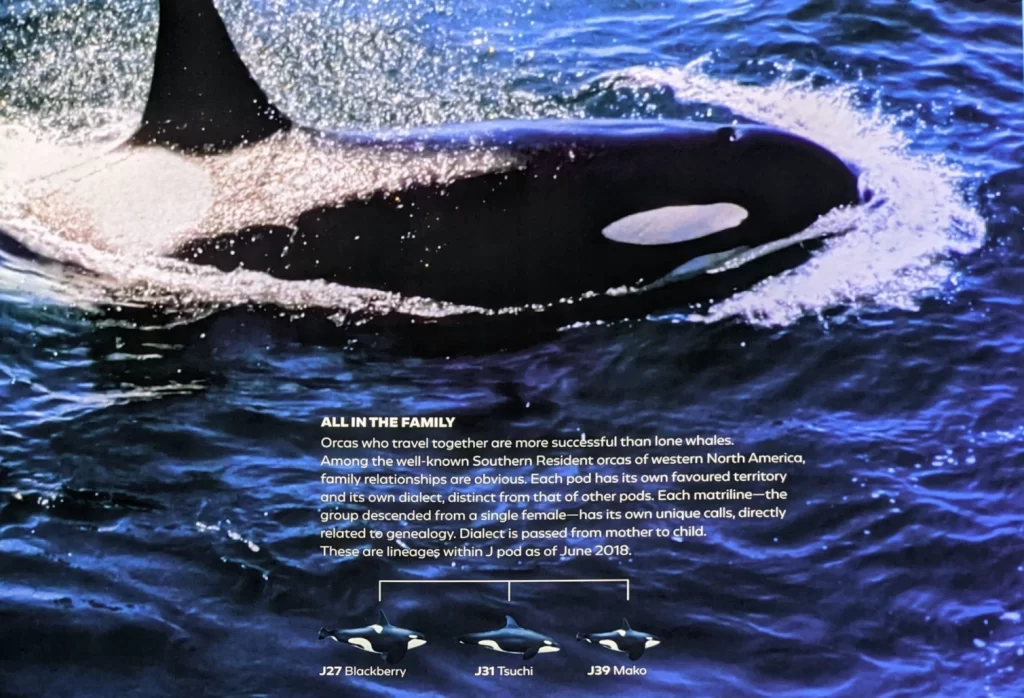
Here’s one fact that amazed me the most in this section: Orcas used to live and walk on land, before entering the water about 50 million years ago, which caused their back legs to get smaller, their tails grew long and powerful, and their nostrils turned into blowholes! The earliest known orcas (Pakicetus) had ankle bones similar to a cow’s, deer’s, or hippo’s, and the latter is the closest living relative of today’s whales.
Man, the animal world has so many surprises to show to us humans!

The next stop of this exhibit was the Indigenous Views Gallery, which told visitors about the strong significance that orcas have had for local coastal and inland tribes for many years. As per Lou-Ann Neel, Curator of Indigenous Collections of the Royal BC Museum, orcas are perceived as family, and these groups believe that orcas feel the same way, because they are so gentle and friendly to us.
They are respected like elders, and some nations are convinced that their loved ones are reincarnated as orca whales after passing away. Orcas can also transform themselves into humans and other animals, and talk to all of these beings, to share their wisdom, wealth, power, and healing.
I was very impressed by these beliefs, but also by the stunning art pieces displayed in this gallery. There were 100+ indigenous artifacts, and a lot of them were traditional work, like a large orca carving, and a button blanket with Killer Whale crest by Elizabeth Kasalas Hunt of the Kwagu??, Kwakwaka’wakw tribe, which was made before 1897, but also contemporary art.
My personal favourite was a screen print reproduction called “Killerwhales”, that was created by Don Yeomans from the Haida people in 1999, because I thought that the blue, red, white, and black colours match very well.
Last but not least, there were animations by two young Haida artists, telling stories about orcas that have been passed on to younger generations for many years!
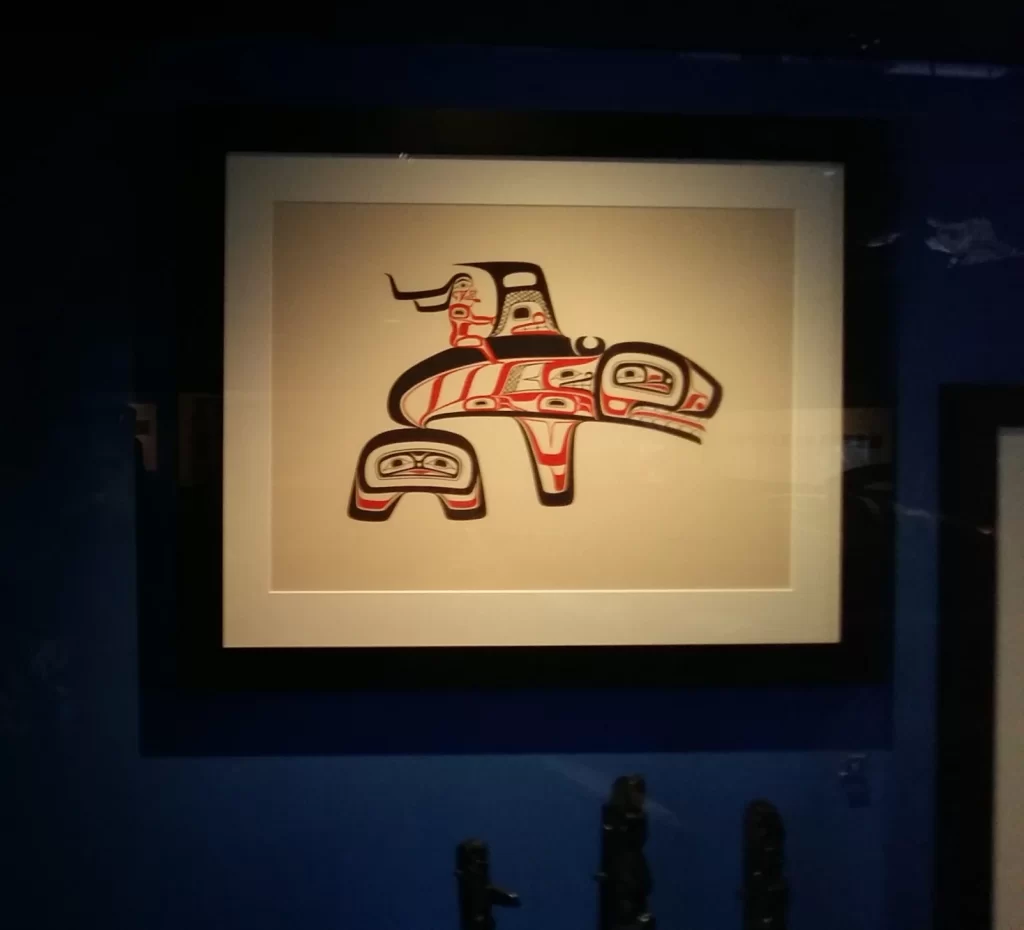
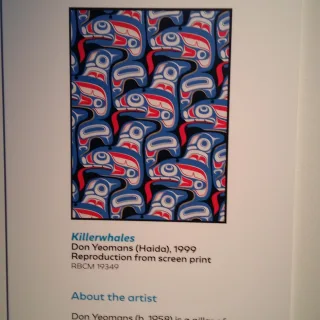
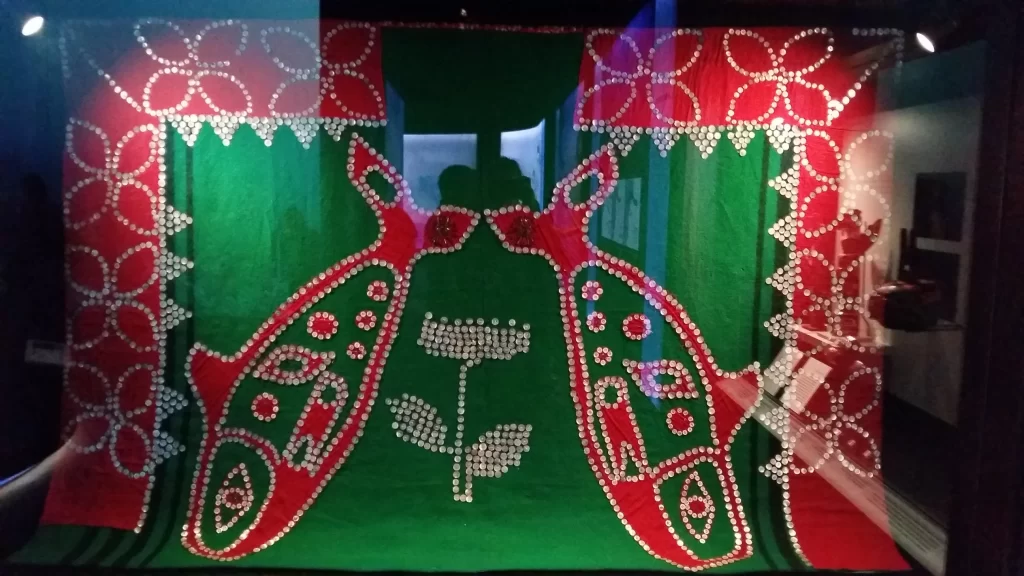

From the top left to bottom right: “Scana with the Woman” screenprint reproduction by Freda Diesing of the Haida people (1980), Button blanket with Killer Whale crest by Elizabeth Kasalas Hunt, “Killerwhales” by Don Yeomans, and orca carving,
Now it was time to check out the Science Section of the exhibit, that had a bunch of great information about orcas as well. One of the best parts, in my opinion, was a real skeleton of Rhapsody, another local Southern Resident orca, that hung down from the ceiling! Sadly, Rhapsody was pregnant when she died in 2014, and her calf’s bones were displayed underneath her skeleton.
Next, you could look at (and touch!) a silicone replica of an orca brain next to a human’s brain, it’s amazing that the orca one is almost 4 times bigger than the human’s (5 kg vs. 1.3 kg/11 lbs vs. 2.8 lbs)!
There was no way to miss the scientific equipment from various decades, that’s been used to support orca research in BC and around the world, like drones, hydrophones, a tape recorder, and a digital acoustic recording tag. The latter is needed to find out the speed and orientation of whales while they swim, both during the day and at night!
Last but not least, I learnt that orcas can hear frequencies of 0.5 Hz to more than 120,000 Hz (in comparison, a human can hear frequencies of 20 Hz to 20,000 Hz), and use echolocation (i.e. reflected sounds), to find and hunt their prey.
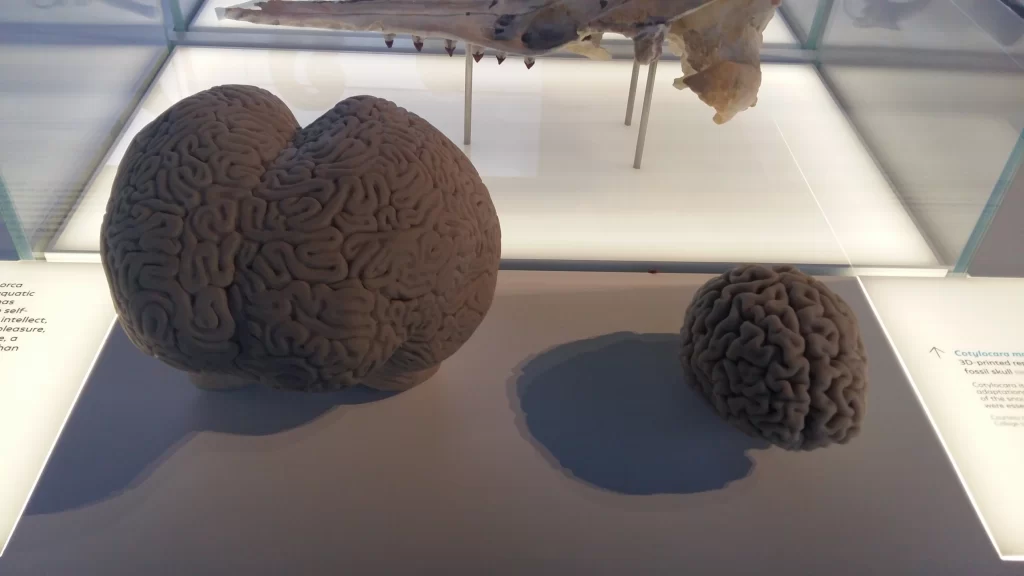
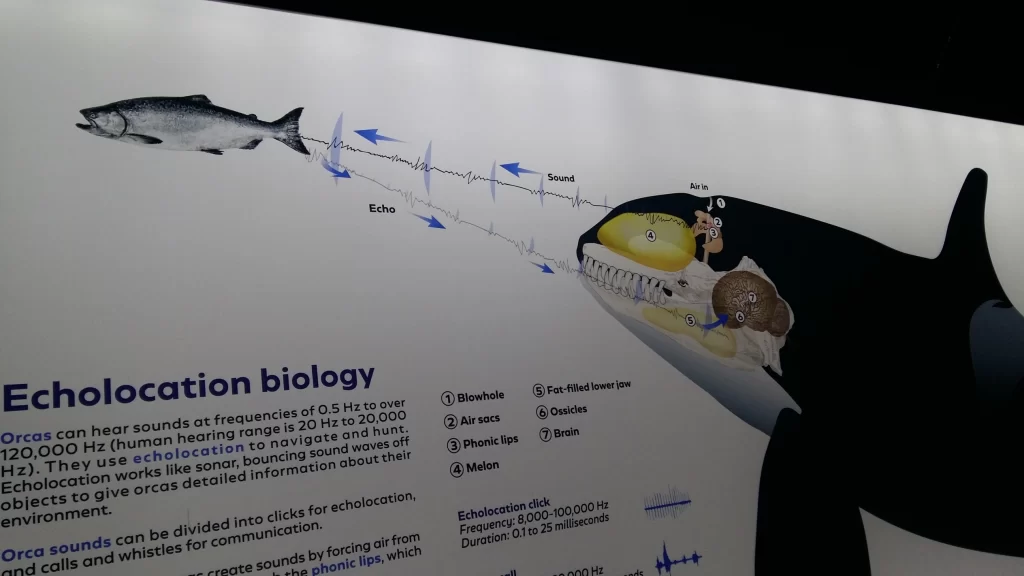
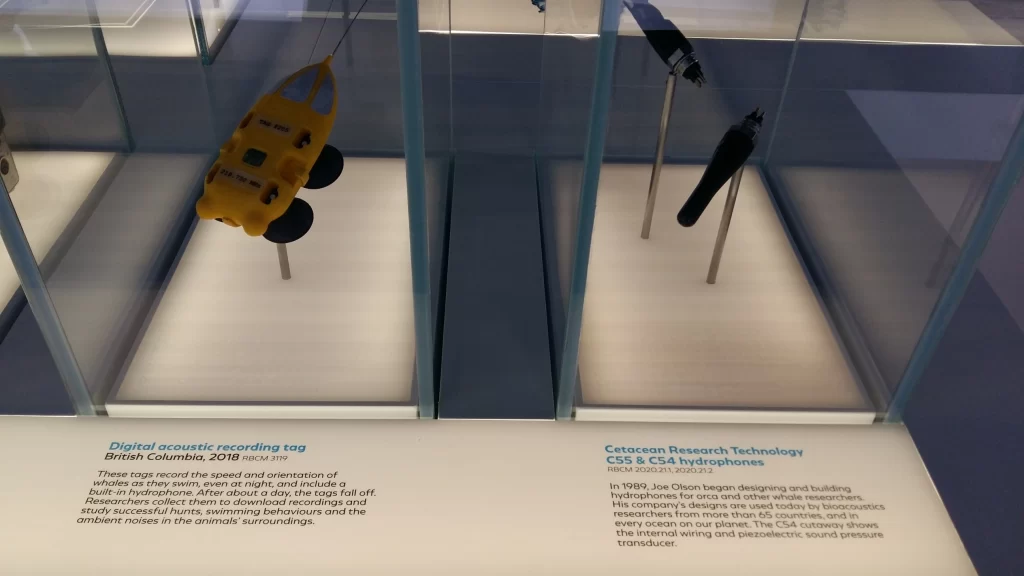
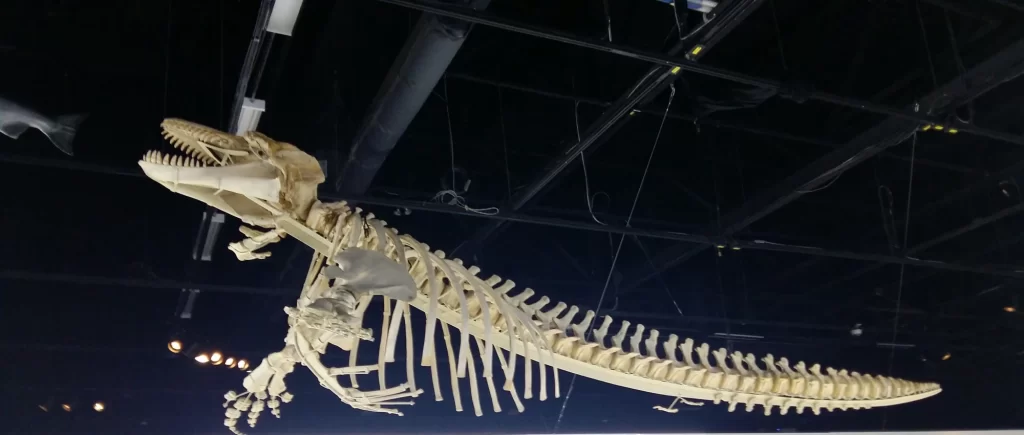
From the top left to bottom right: silicone replica of an orca brain vs. a human’s, scientific equipment to research orcas whales’ behaviour, partial panel about orcas finding their prey through echolocation, and Rhapsody’s skeleton.
Next, let’s look at a dark era of orca history, which was caused by human beings. I’m talking about Orca Captivity, that first started close to Saturna Island in BC in 1964, when Moby Doll was captured and later taken to the Vancouver Aquarium.
Before that, humans never got this close to an orca, and marine scientists were able to study them close-up for the first time. For many years, orcas were seen as “killer whales” in Western culture, and many people were scared of them, but then, they learnt what Indigenous cultures had known for a long time: Orcas are intelligent and friendly creatures towards us humans, so they fell in love with them.
Soon after, more orcas and other marine creatures were captured, and marine theme parks and aquariums featuring them opened their doors, like SeaWorld in Orlando, Florida, and Loro Parque in Tenerife, Spain. These marine theme parks were incredibly popular in earlier decades, and the exhibit displayed some original material, like a trainer’s wetsuit, and tons of rare footage. Some of it hadn’t been shown to the public in 40 years!
Moreover, there was no way to miss the Wall of Commercial Photographs, which were supposed to promote a fun time for the entire family, and the small movie theatres in the exhibit showed rare film footage, too.
But with time, it became obvious that taking orcas away from their families (often at a young age), and forcing them to perform and spend the rest of their lives in a tiny pool terribly affects their mental and physical health. In the wild, orca families stay together for their entire life, and if there are conflicts with other pods, they can get away from each other, but this is not possible in captivity.
Another sign of stress and mental trauma is a floppy dorsal fin, which commonly happens to orcas in captivity, but only to 1% of them living in the wild. Nowadays, life captures of orca whales are banned in BC, but they are still captured and bred in marine theme parks in other parts of the world.
After taking in this sad (but I think, important to know) information, I moved on to the next section, Orcas in Popular Culture. In the past, several orcas gained fame while participating in popular movies, like Namu, the Killer Whale (1966) and Free Willy (1993), and this section featured the original movie posters, and a detailed biography of each famous orca.
I’ve loved Free Willy since I was a kid, and Keiko, the whale who played Willy, was the first orca being released back to the wild in 1998, after children around the world had raised money to make this possible. Of course, it’s devastating that Keiko wasn’t able to survive on his own for long, and passed away because of pneumonia in 2003.
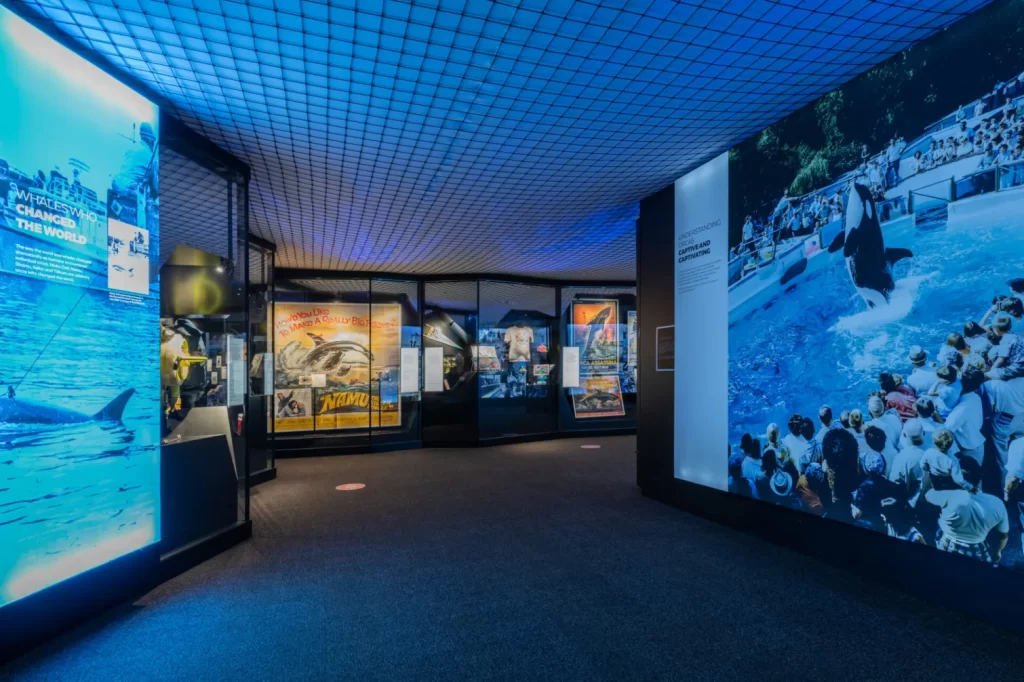
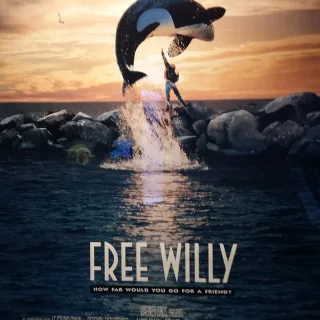
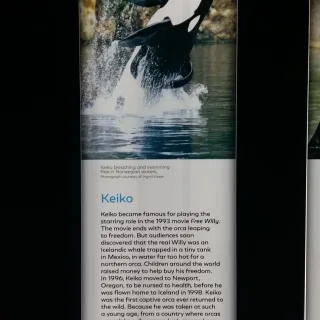
Original movie poster of Free Willy and Keiko’s detailed biography.
Thankfully, the popularity of marine theme parks has decreased drastically in recent years. One reason for this is the documentary Blackfish, published in 2013, which shows how much orcas suffer in captivity, and how this affects their mental and physical health, and other beings around them. The “main character” of this movie is Tilikum (1981-2017), an orca who lived in captivity for many years, and killed several of his trainers. The original movie poster of this movie was displayed in this section as well.
With time, several orca rights organizations were founded, such as the Free Morgan Foundation, who fights for Morgan, a malnourished orca whale who was rescued off the coast of the Netherlands in 2010, but once she was cured, was taken to Loro Parque in Tenerife, Spain, instead of being returned to the wild.
In 2018, Morgan gave birth to a calf, Ula, from whom she was separated right after, and last year, Ula died, at only 3 years old. Until today, Morgan still lives at Loro Parque, so hopefully, she’ll be freed someday!
According to Dr. Lorne Hammond, Curator of History at the Royal BC Museum, children who visited marine theme parks often become teenage activists, who fight for orca rights. My family and I visited SeaWorld in Orlando, Florida, in 1993, but after my mother learnt about these horrible conditions, we never went to one of these places again.
I only became an animal (including orcas) activist in my early Twenties, though! 😉
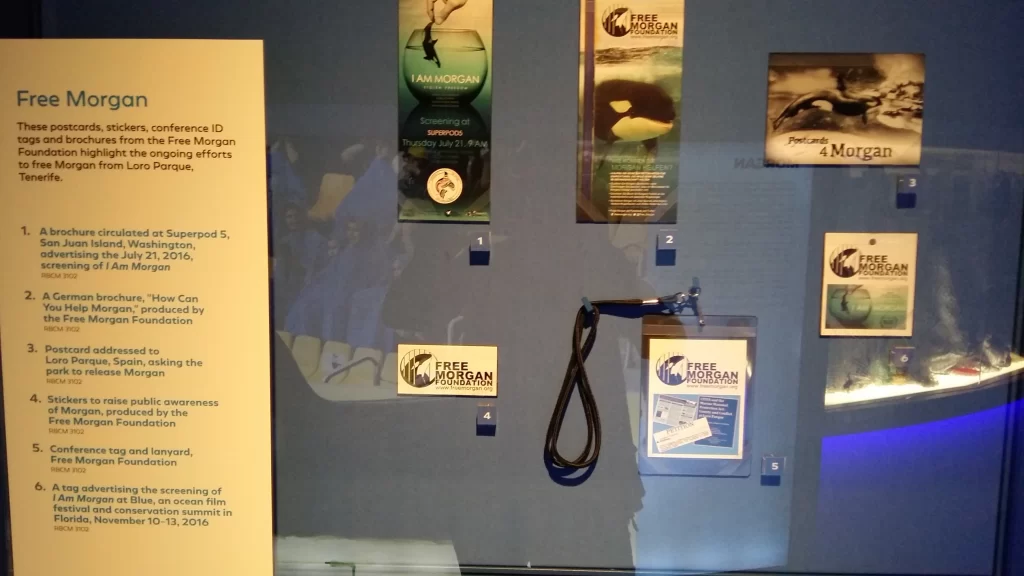
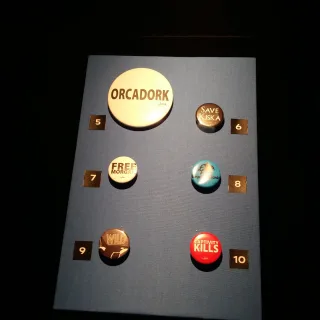
Collaterals from the Free Morgan Foundation and buttons that support orca rights.
A much more ethical way to get close to orcas is Whale Watching. There are several whale watching companies in Victoria and the rest of Vancouver Island, and many people like to support them, especially national and international visitors.
Of course, it’s not guaranteed to see orcas and other marine creatures (like in an aquarium), but I think it’s worth it, to see them happily swimming around their natural environment, and either way, it’s always exciting to be out on a boat!
If you’re out with a tour group, the tour leader tries his/her best to make the whales feel comfortable while they’re being looked at. For example, he/she would turn off the boat’s motor, or it’s switched for a quieter electrical motor, and the boat is within a kilometer (0.6 miles) of the whales.
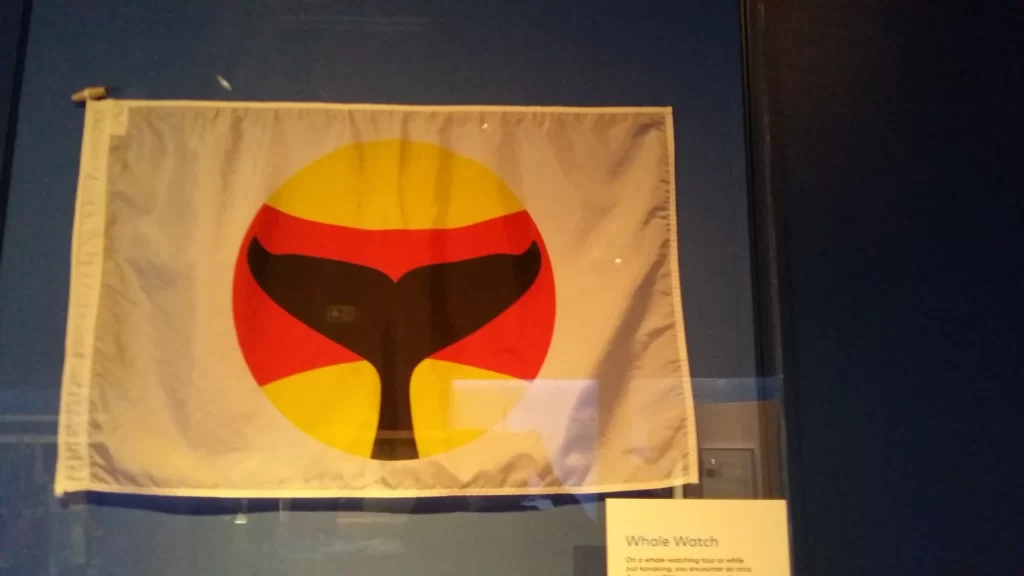
The Signal Flag, introduced by the North Island Marine Mammal Stewardship Association.
Although capturing orcas to perform is much less popular nowadays, there are still other man-made threats that orcas and their fellow sea dwellers have to deal with. Orcas are apex predators, so same as humans, they don’t have any natural enemies.
Some major threats are starvation, often because of overfishing, air and noise pollution, habitat destruction, climate change, and (plastic) trash found in the oceans.
Remember Scarlet, one of the 3D printed orca replicas who greeted us in the beginning of our tour? Unfortunately, she’s not with us anymore, as she passed away from malnutrition in 2018, at only 4 years old. Moreover, her clan, the Southern Resident Orcas, are endangered because of these issues.
So this section wants to show visitors how some of our behaviour influences the lives of orcas, either directly or indirectly, and us as well in the future, because everything is connected.
There was the Ocean Health interactive table, on which you could move pieces around, to learn how our habits affect the health of the oceans and orcas. What a cool way to learn about these issues, for both kids and adults!
One of the Royal BC Museum’s slogan was “Orcas need clean, quiet oceans, and pollution-free food. What about you?”, and I think that’s all that needs to be said to motivate humans to think about how we can improve, so hopefully, we can all live together in peace someday!
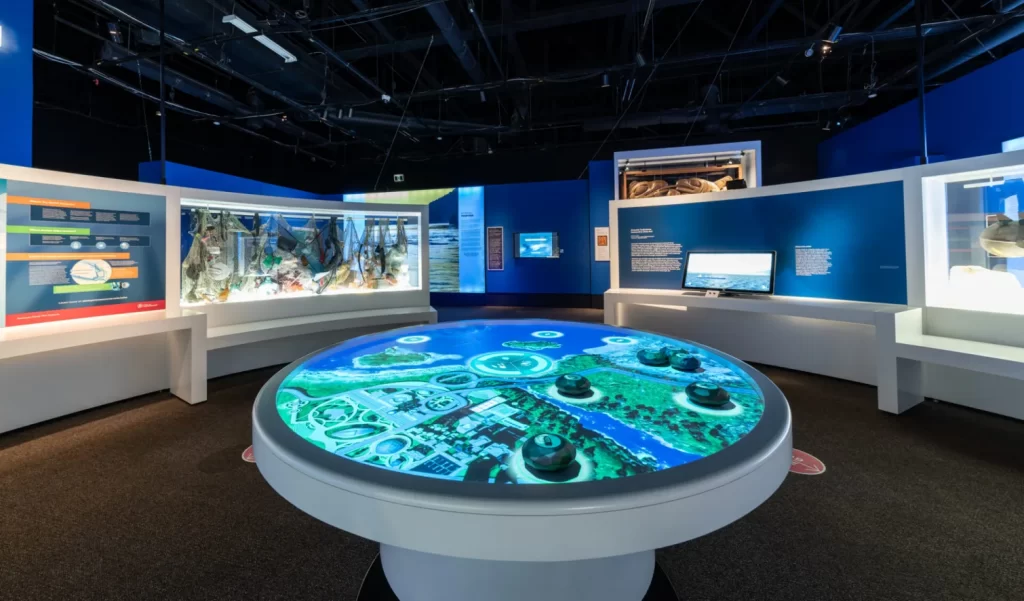
This was the end of the Orcas exhibit, and wow, I’m amazed by all the great things I learnt about these magnificent marine mammals!
The Royal BC Museum is open daily from 10 am – 5 pm, and tickets are valid all day, for all exhibits, so it’s a great way to spend a cold or rainy day in Victoria! I recommend to arrive fairly early, so you’re in no rush to explore the museum. Visitors are strongly encouraged to buy tickets through the museum’s website here. You can also buy combination tickets to visit both the museum and the IMAX theatre!
CONTACT INFORMATION
Royal BC Museum
675 Belleville Street
Victoria BC
V8W 9W2
Telephone: +1 250-356-7226
Email: reception@royalbcmuseum.bc.ca
MUSEUM ADMISSION PRICES
Adult (19+) $29.95
Senior (65+) $19.95
Youth (6-18) $16.95
Student (19+ w/ ID) $19.95
Child (3-5) Free
What I really liked about this exhibit is that it was fully accessible to everyone. The museum is fully wheelchair accessible, elevators are provided, and several benches are available if you’d like to take a break.
But wait, of course, no museum visit is complete without checking out the gift shop, lol! It’s on the ground floor of the Royal BC Museum, and upon entering, a bunch of cool orca souvenirs (e.g. t-shirts, books, stuffed animals, and chocolate) grabbed my attention.
But if you keep on walking around the store, there are even more nice things, like gifts made or designed by local indigenous people, games, jewelry, puzzles, and other items related to exhibits at the Royal BC Museum.
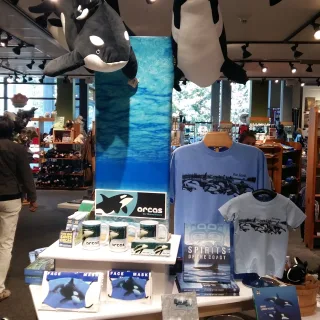
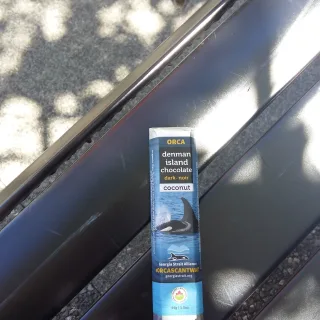
Awesome orca souvenir selection at the Royal BC Museum’s gift shop, and really yummy orca chocolate 😛
Thank you for checking out my blog today 🙂 Cheers!

